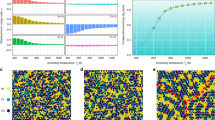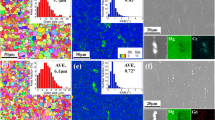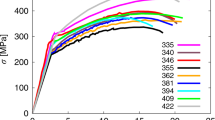Abstract
Dynamic strain ageing (DSA) is the phenomenon in which solute atoms diffuse around dislocations and retard dislocation motion, leading to negative strain-rate sensitivity (nSRS) and thus to material instabilities during processing, an important issue in commercial metal alloys. Here, we show the mechanism of DSA and nSRS on experimental strain-rate, temperature and stress scales for Al–Mg to be single-atomic-hop motion of solutes from the compression to the tension side of a dislocation core. We derive an analytic expression for the strengthening versus strain rate and temperature that justifies widely used phenomenological forms, provides specific dependences of the parameters on material properties and is supported by atomistic kinetic Monte Carlo simulations. Using literature material properties, the predicted strengthening quantitatively agrees with the experimentally derived behaviour of Al–2.5% Mg at 300 K, and qualitatively agrees with the strain rate and temperature ranges of DSA and nSRS in Al–Mg alloys. The analyses herein show a clear path for multiscale design, from quantum to continuum mechanics, of solute strengthening in face-centred-cubic metal alloys.
This is a preview of subscription content, access via your institution
Access options
Subscribe to this journal
Receive 12 print issues and online access
$259.00 per year
only $21.58 per issue
Buy this article
- Purchase on Springer Link
- Instant access to full article PDF
Prices may be subject to local taxes which are calculated during checkout






Similar content being viewed by others
References
Hirth, J. P. & Lothe, J. Theory of Dislocations 2nd edn (Wiley, New York, 1982).
Robinson, J. M. & Shaw, M. P. Microstructural and mechanical influences on dynamic strain aging phenomena. Int. Mater. Rev. 39, 113–122 (1994).
Cottrell, A. H. & Bilby, B. A. Dislocation theory of yielding and strain ageing of iron. Proc. R. Soc. A 62, 49–62 (1949).
Cottrell, A. H. Theory of brittle fracture in steel and similar metals. Trans. Met. Soc. AIME 212, 192–203 (1958).
Friedel, J. Dislocations (Addison-Wesley, New York, 1964).
Louat, N. On the theory of the Portevin-Le Châtelier effect. Scripta Metall. 15, 1167–1170 (1981).
McCormick, P. G. A model for the Portevin-Le Châtelier effect in substitutional alloys. Acta Metall. 20, 351–354 (1972).
van den Beukel, A. Theory of the effect of dynamic strain aging on mechanical properties. Phys. Status Solidi A 30, 197–206 (1975).
Estrin, Y. & Kubin, L. P. Collective dislocation behaviour in dilute alloys and the Portevin-Le Châtelier effect. J. Mech. Behav. Mater. 2, 255–292 (1989).
Kubin, L. P. & Estrin, Y. Evolution of dislocation densities and the critical conditions for the Portevin-Le Châtelier effect. Acta Metall. Mater. 38, 697–708 (1990).
Kubin, L. P. & Estrin, Y. The critical conditions for jerky flow: discussion and application to Cu-Mn solid solutions. Phys. Status Solidi B 172, 173–185 (1992).
Estrin, Y. & Kubin, L. P. in Continuum Models for Materials with Microstructure (ed. Mühlhaus, H. B.) 395–450 (Wiley, Chichester, 1995).
Lebyodkin, M., Dunin-Barkovskii, L., Bréchet, Y., Kubin, L. & Estrin, Y. Kinetics and statistics of jerky flow: experiments and computer simulations. Mater. Sci. Eng. A 234–236, 115–118 (1997).
Lebyodkin, M., Dunin-Barkovskii, L., Bréchet, Y., Estrin, Y. & Kubin, L. P. Spatio-temporal dynamics of the Portevin-Le Châtelier effect: experiment and modelling. Acta Mater. 48, 2529–2541 (2000).
Zhang, S., Estrin, Y. & McCormick, P. G. The morphology of Portevin-Le Châtelier bands: finite element simulation for Al-Mg-Si. Acta Mater. 49, 1087–1094 (2001).
Kok, S. et al. Spatial coupling in jerky flow using polycrystal plasticity. Acta Mater. 51, 3651–3662 (2003).
Penning, P. Mathematics of the Portevin-Le Châtelier effect. Acta Metall. 20, 1169–1175 (1972).
Fujikawa, S. & Hirano, K. Diffusion of 28Mg in aluminum. Mater. Sci. Eng. 27, 25–33 (1977).
Picu, R. C. & Zhang, D. Atomistic study of pipe diffusion in Al-Mg alloys. Acta Mater. 52, 161–171 (2004).
Picu, R. C. A mechanism for the negative strain-rate sensitivity of dilute solid solutions. Acta Mater. 52, 3447–3458 (2004).
Rizzi, E. & Hahner, P. On the Portevin-Le Chatelier effect: theoretical modeling and numerical results. Int. J. Plast. 20, 121–165 (2004).
Barnett, D. M., Oliver, W. C. & Nix, W. D. The binding force between an edge dislocation and a Fermi-Dirac solute atmosphere. Acta Metall. 30, 673–678 (1982).
Barnett, D. M., Wong, G. & Nix, W. D. The binding force between a Peierls-Nabarro edge dislocation and a Fermi-Dirac solute atmosphere. Acta Metall. 30, 2035–2041 (1982).
Klose, F. B. et al. Analysis of Portevin-Le Chatelier serrations of type B in Al-Mg. Mater. Sci. Eng. A 369, 76–81 (2004).
Picu, R. C. et al. Strain rate sensitivity of the commercial aluminum alloy AA5182-O. Mater. Sci. Eng. A 390, 334–343 (2005).
Olmsted, D., Curtin, W. A. & Hector, L. G. Molecular dynamics study of solute strengthening in Al/Mg alloys. J. Mech. Phys. Solids 54, 1763–1788 (2006).
Fivel, M. C., Gosling, T. J. & Canova, G. R. Implementing image stresses in a 3D dislocation simulation. Model. Simul. Mater. Sci. Eng. 4, 581–596 (1996).
Hiratani, M., Zbib, H. M. & Khaleel, M. A. Modeling of thermally activated dislocation glide and plastic flow through local obstacles. Int. J. Plast. 19, 1271–1296 (2003).
Amodeo, R. J. & Ghoniem, N. M. Dislocation dynamics. I. A proposed methodology for deformation micromechanics. Phys. Rev. B 41, 6958–6967 (1990).
Devincre, B. & Condat, M. Model validation of a 3D simulation of dislocation dynamics. Acta Metall. Mater. 40, 2629–2637 (1992).
Ercolessi, F. & Adams, J. B. Interatomic potentials from first-principles calculations: the force matching method. Europhys. Lett. 26, 583–588 (1994).
Liu, X.-Y., Adams, J. B., Ercolessi, F. & Moriarty, J. A. EAM potential for magnesium from quantum mechanical forces. Model. Simul. Mater. Sci. Eng. 4, 293–303 (1996).
Liu, X.-Y., Ohotnicky, P. P., Adams, J. B., Rohrer, C. L. & Hyland, R. W. Anisotropic surface segregation in Al-Mg alloys. Surf. Sci. 373, 357–370 (1997).
Olmsted, D. L., Hector, L. G., Curtin, W. A. & Clifton, R. J. Atomistic simulations of dislocation mobility in Al, Ni and Al/Mg alloys. Model. Simul. Mater. Sci. Eng. 13, 371–388 (2005).
Labusch, R., Ahearn, J., Grange, G. & Haasen, P. in Rate Processes in Plastic Deformation: Proceedings from the John E. Dorn Symposium Vol 56 (eds Dorn, J. E., Li, J. C. M. & Mukherjee, A. K.) (American Society for Metals, Metals Park, Ohio, 1975).
Zaiser, M. Dislocation motion in a random solid solution. Phil. Mag. A 82, 2869–2883 (2002).
Ionova, I. V. & Carter, E. A. Ridge method for finding saddle points on potential energy surfaces. J. Chem. Phys. 98, 6377–6386 (1993).
Voter, A. F. in Radiation Effects in Solids (eds Sickafus, K. E. & Kotomin, E. A.) Ch. 1 (Springer, NATO Publishing Unit, Dordrecht, The Netherlands, 2006).
Acknowledgements
The authors gratefully acknowledge support of this work by the General Motors/Brown Collaborative Research Laboratory on Computational Materials Science and the NSF Materials Research Science and Engineering Center on Micro and Nanomechanics of Materials at Brown University. W.A.C. thanks the John Simon Guggenheim Foundation for a fellowship, during which important components of this work were carried out, and C. Picu, B. Devincre and L. Kubin for discussions.
Author information
Authors and Affiliations
Corresponding author
Ethics declarations
Competing interests
The authors declare no competing financial interests.
Rights and permissions
About this article
Cite this article
Curtin, W., Olmsted, D. & Hector, L. A predictive mechanism for dynamic strain ageing in aluminium–magnesium alloys. Nature Mater 5, 875–880 (2006). https://doi.org/10.1038/nmat1765
Received:
Accepted:
Published:
Issue Date:
DOI: https://doi.org/10.1038/nmat1765
This article is cited by
-
Diffusive migration behavior of single atoms in aluminum alloy substrates: Explaining machine-learning-accelerated first principles calculations
Science China Materials (2024)
-
Tensile and creep behavior of 316L austenite stainless steel at elevated temperatures: experiment and crystal plasticity modeling
Acta Mechanica Sinica (2024)
-
Accelerating the design of compositionally complex materials via physics-informed artificial intelligence
Nature Computational Science (2023)
-
An analysis of the hot forming characteristics of diffusion-bonded TC4 alloy using processing maps
The International Journal of Advanced Manufacturing Technology (2023)
-
Influence of Deformation Temperature On Flow Stress and Dislocation Structure of 2A12 Aluminum Alloy Under Quasi-Static and Dynamic Compression
Experimental Mechanics (2023)



